...Homepage Suite
(go to starting homepage)
APUQ Zero Pollution QT Pneumatic Car
Disclosed on September 25, 2005
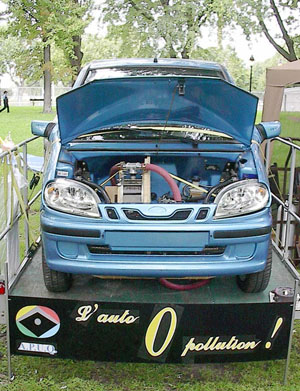
www.promci.qc.ca/pureinvention/apuq/APUQAutoPneumatique.htm
Video 350 Kb at:
quasiturbine.promci.qc.ca/QTVideos/ApuqAutoEssai060430Depart.wmv
May 2006 - TV news at LCN and TVA
quasiturbine.promci.qc.ca/QTVideos/QTAPUQTvaLcnTV060527.wmv
APUQ Pneumatic 12 volts alternator
The objective is to have an alternator on each side do the QT!
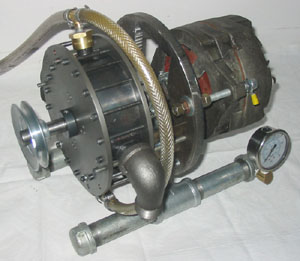
www.promci.qc.ca/pureinvention/apuq
/APUQGeneratricePneumatique.htm
A similar Steam Generator is also in project
www.promci.qc.ca/pureinvention/apuq/APUQGeneratriceVapeur.htm
Engine Exhaust Heat Recovery
Better than hybrids? Recovering 30% of the engine exhaust heat would allow to
exceed most hybrid efficiency performance. By placing a hot Quasiturbine into or
around an engine exhaust pipe, and injecting pressurized hot water (steam keep
in the liquid state for better heat transfer), some heat can be recovered into
mechanical energy. A Quasiturbine Stirling or short steam circuit could do
similarly! See:
Engine Exhaust Heat Recovery with Quasiturbine
Applicable to Solar Heat
The concept of Quasiturbine Solar Steam
quasiturbine.promci.qc.ca/ETypeSteam.htm
The Quasiturbine researcher team has initially established a list of 30 conceptual
piston deficiencies
and as many
Wankel deficiencies
. The Quasiturbine general concept is the result
of an effort to improve both engines by suppressing the limiting
sinusoidal crankshaft and offering up to 7 degrees of freedom at design.
Quasiturbine Definition
The
Quasiturbine (Qurbine) or
Kyotoengine
is a pressure driven continuous torque deformable spinning
wheel; a no crankshaft rotary engine having a 4 faces articulated rotor
with a free and accessible center, rotating without vibration nor dead
time, and producing a strong torque at low RPM under a variety of modes
and fuels. The Quasiturbine can also be used as air motor, steam engine,
Stirling engine, compressor and pump. The Quasiturbine is also an
optimization theory for extremely compact and efficient engine concepts.
The Quasiturbine is at the crossroad of the 3 modern engines: Inspired
by the turbine,
it perfects the piston, and improves upon the Wankel. The Quasiturbine is
universal in relation to energy sources: Liquid and gaseous fuel,
hydrogen, steam, pneumatic, hydraulic... The Quasiturbine engine was
invented by the Saint-Hilaire family and first patented in 1996.
The engine makes use of a complex computer calculated oval shape stator
housing, creating regions of increasing and decreasing volumes as the
rotor turns. It is capable of burning fuel using detonation, the optimal
combustion mode of the future... the piston cannot stand.
How it Works
In the Quasiturbine engine, the four strokes of a
typical cycle de Beau de Rochas (Otto) cycle are arranged sequentially
around a near oval, unlike the reciprocating motion of a piston engine. In
the basic single rotor Quasiturbine engine, an oval housing surrounds a
four-sided articulated rotor which turns and moves within the housing. The
sides of the rotor seal against the sides of the housing, and the corners
of the rotor seal against the inner periphery, dividing it into four
chambers.
|
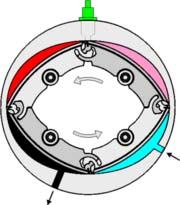
|
Quasiturbine
combustion cycle
Intake (aqua),
Compression (fuchsia),
Combustion (red),
Exhaust (black).
A spark plug is located
at the top (green)
|
As the rotor turns, its motion and the shape of the
housing cause each side of the housing to get closer and farther from the
rotor, compressing and expanding the chambers similarly to the "strokes"
in a reciprocating engine. However, whereas a four stroke piston engine
produces one combustion stroke per cylinder for every two revolutions, the
chambers of the Quasiturbine rotor generate height combustion "strokes"
per two rotor revolutions; this is eight times more than a four-strokes
piston engine.
Because the Quasiturbine has no crankshaft, the
internal volume variations do not follow the usual sinusoidal engine
movements, which provide very different characteristics from the piston or
the Wankel engine. Contrary to the Wankel engine where the crankshaft
moves the rotary piston face inward and outward, each Quasiturbine rotor
face rocks back and forth in reference to the engine radius, but stays at
a constant distance from the engine center at all time, producing only
pure tangential rotational forces.
The four strokes piston has such a long dead time,
its average torque is about 1/8 of the peak torque, which dictate the
robustness of the piston construction. Since the Quasiturbine has not dead
time, average torque is only 30% lower than the peak torque, and for this
reason, the relative robustness of the Quasiturbine need be only 1/5 of
that of the piston, allowing for an additional engine weight saving...
Turbine Comparison - Competitiveness
The Quasiturbine share with the conventional turbine
the most valuable characteristic of torque continuity (even if not
constant, there is no propulsive dead time), that very few other engine
concept offer. Being a balanced configuration with near zero seal movement
machine, nothing prevents the scaling up of the Quasiturbine to the 10
megawatts range or more. Contrary to complex conventional turbines, the
Quasiturbine are competitively down scalable to low power units, easy to
operate, and do not require as sophisticated trained maintenance
personnel.
Hydraulic, pneumatic, steam, gas and fuel
combustion... produce primary energy in the form of expansion and
pressure. Being an hydro-aero-static device, the Quasiturbine directly
transforms this pressure energy into mechanical rotation motion with
optimum efficiency, whatever low or high is the pressure (QT idle with
only a few psi !). Conventional turbines are hydro-aero-dynamic, and they
cannot handle directly the energy of pressure which must be converted into
kinetic energy. For a given geometry, the efficiency of conventional
turbine falls rapidly if the flow velocity moves away from the optimum.
Because the Quasiturbine does not require the
pressure energy to be converted into the intermediary form of kinetic
energy, it has numerous advantages over the conventional turbines,
including on the efficiency at all regimes.
A conventional turbine is so demanding in term of
flow control, rpm and load, it has to be the central dominant equipment to
which all other system application components must be slaved. In contrary,
the Quasiturbines can be efficiently slaved to a variety of different
applications.
Quasiturbine Solution
Detonation and hybrid are two different means to harvest the low
efficiency of reduced power piston engine, and both are compatible with
efficient electrical (in-wheel) power train. Detonation engine is however a more
direct and efficient way, and because the « on board fuel » is already a form of
energy storage, detonation engine avoid to re-stock this energy electrically
into batteries. The chemical energy stored in the fuel is
degraded when chemically re-stored in batteries.
Many researches are going on to increase energy
efficiency on the long term with piston, hydrogen, fuel cell... Hybrid
concepts are ways to harvest part of the "low power efficiency penalty" of
the piston engine used in vehicle, but counter-productive measures limit
the long term perspective until they could efficiently fuel from the
electrical grid. None of these solutions are short term stable and
competitive.
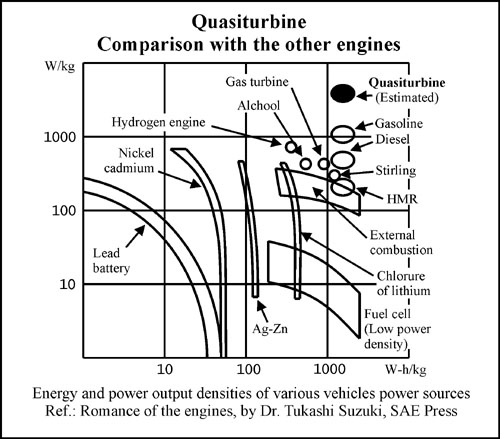
The Quasiturbine in Beau de Rocha (Otto) cycle is a
relatively simple technology which could be widely used within a few years
with substantial efficiency benefits over piston engines in many
applications. Large utility plants convert energy more efficiently than
small distributed units and should be favored when possible, but on the
long term, the Quasiturbine detonation engine is one of the very few means
to match utility efficiency the distributed way, while being as chemically
clean as possible. Not only the photo-detonation suppresses the energy
consuming butterfly vacuum intake valve and so preserving the engine
efficiency at low power, but since it requires a much higher compression
ratio, it does increases the engine efficiency at full throttle as well.
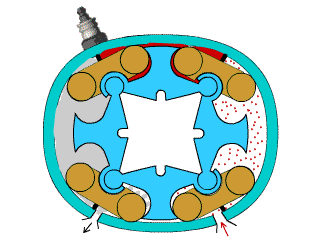
QT-AC (With carriages) is intended for detonation mode,
where high surface-to-volume ratio
is a factor attenuating the violence of detonation.
The next step in world engine research is to make the gas engine as
efficient as the diesel engine, and the diesel engine as clean as the gas
engine. The photo-detonation Quasiturbine AC does that and more, by conciliating
both gas (homogeneous) and diesel (non-homogeneous) engines in one extremely
efficient and clean photo-detonation mode, leading the way to a major efficiency
breakthrough! Photo-detonation permits 2 efficiency gain improvements: The
removal the butterfly intake vacuum valve (engine compression breaking - which
exist at all time within gas engine), and the increase of the compression ratio
(well over the knocking and the diesel level). Because the combustion is
homogeneous and occurs in excess of air, it is as clean as an external
combustion.
Not to confuse the ignition process
(the sparkplug and the diesel thermo ignition)
with the combustion mode (thermal wave or detonation)
Notice there is no detonation in diesel engine.
Photo-detonation self-fires similarly to Diesel,
but burn homogeneously, faster and cleaner.
This mode uses a « fast detonation chamber »
instead of a « combustion chamber ».
www.quasiturbine.promci.qc.ca/EQTPhotodetonation.html
Quasiturbine has extra degrees of freedom allowing
for thermodynamic and photo-detonation optimization, which other
simplified mathematical concepts like piston or Wankel can not pretend. By
opposition to dozens of new engine designs, the most important at this
time about the Quasiturbine is the fact that it does unknot a new field of
development and offers means to achieve what no other engine design has
suggested or is able to, and specially for detonation where piston engine
has failed for over 40 years...
Why a Better Engine?
In their book about the Quasiturbine
, the inventors have used a set of 14
engine parameters to show than none of the modern engine meets
simultaneously all the optimum general demanding criteria. Engines fail to
be "all in one" compact, low weight, low noise, zero vibration, high
torque at low rpm, efficient on a wide power range... While having
homogeneous clean combustion and being multi fuel capable... With our
today's Beau de Rocha (Otto) mode piston gas engine, about half the
gasoline used in the transportation sector is literally wasted to fight
the intake atmospheric vacuum depression generated by the carburetor or
injector manifold butterfly-valve (The engine-braking effect). This is
half the pollution of the transportation activities!
Engines are at the end of the energy chain, and their
pollutions affect the most immediate users environment. Better engines are
keys to better environment, not only because of their own improved
efficiencies, but also because any bit of improvement has directly
amplified impacts on all anterior stages of the energy cascade and
industry. This is the reason for Quasiturbine!
Last Drops of Fossil Fuel?
If one day we are going to limit the availability of fossil
fuel, in which type of engine would you put the precious liquid ? Without a
doubt in the most efficient and clean engine. It is important to develop better
engines regardless of the abundance or the rarity of the fossil fuel, to
attenuate the effect of the inevitable transition and in the perspective of the
precious synthetic replacement fuel. The efficient engine development is part of
the measures intended to better prepared ourselves to tackle the future...
Closer we will get to the end of the fossil era, more the performing engines
will be necessary and appreciated!
Fossil Fuel and Renewable Energy
The comparison is somewhat unfair. First, fossil fuel comes
from pumping an underground reservoir – it is not man-activity stored energy.
Second, comparing text book fossil fuel energy contain of about 9000 W-h/Kg with
renewable energy systems is further unfair. One Kg of fossil fuel contains “no
energy at all, if you do not have oxygen to combust it - on the moon for
example”. For mobile applications, the truth is that to combust a typical car
gas tank, one need about 2 tones of oxygen, which is taken out of the
environment while underway… but should be onboard for matter of fair energy
comparison with renewable systems like mechanical coil spring, compressed air,
batteries or liquid nitrogen… Amazingly, both the fossil fuel and solar panels
systems fail to offer a fair
« onboard total energy system »
comparison in mobile applications. Just keep that in mind for the evaluation of
the future generation of projects…
An Engine and more
The Quasiturbines are highly suitable for many «
traditional systems » like heat pumps (refrigerators, freezers, air
conditioners), pneumatic energy storage, air compressors and water pumps,
hydraulic pump and motor, turbo-pumps, as well as in utility
co-generation, aviation, marine or locomotive propulsion, Combined Cycle
Gas Turbines, Rotary Pressure Expanders for Gas Pipeline Pressure Energy
Recovery or as industrial and nuclear boiler steam vapor energy production
or recovery...
Not only the Quasiturbine can be used as a pneumatic
(air) or steam co-generation engine, but it can run in internal combustion
Otto mode and photo-detonation mode, in Stirling thermal, Brayton and
other cycles. This makes it suitable for cogeneration and conventional
engine exhaust heat recovery (see
QT Type Stirling)
, or for hydro-electric water dams (see
QT Type Hydraulic).
As a rotary expander, it can be used to recover MW of
pressure energy at gas pipeline pressure reduction stations (or steam
pressure reduction stations), and to efficiently replace the expansion
valve in more ecological refrigeration and heat pump air conditioning
systems (removing the mechanical pressure energy which destroys the
cooling efficiency), while offering compression capability. See
quasiturbine.promci.qc.ca/ETypeExpander.htm
Engines in Energy Strategy
The future of energy strategies involve resources,
efficiency, distribution and mobility. Because large utility energy
station transforms fuel into electricity with a higher efficiency than the
small distributed stations or your car engine, there will be a period
during which hybrid, fuelcells (also thermal machines), batteries and
electricity from the grid (electric power train will still be suitable
with onboard efficient generator) will tend to substitute internal
combustion Otto engines. However, as more efficient and photo-detonation
engines will come on the market, and small engines will become as
efficient as large utility stations, this kind of substitution will have
no reason whatsoever. Only then, distributed electric generation will
become reality, and because of fuel mobility specific energy and power
advantages, efficient internal combustion engines will then have no
substitute!
Still the resource will have to be addressed, but the
most likely efficient solution will be toward SYNTHETIC FUEL (from
bio-solar ... or nuclear) similar to conventional fuels, because the best
and most convenient way to store hydrogen is to bond it with carbon atoms
and make a conventional liquid fuel (will we then enter a carbon depletion
era?). For these reasons, no foreseen technology is on the long term going
to substitute efficient combustion engines... toward which research and
development must continue. Those saying that today improved thermal
internal combustion engines come to late in time are missing the point: If
thermal engines were more efficient, no one would talk about hybrid and
hydrogen...
Environmental Concerns
Quasiturbine is also accessible via
www.kyotoengine.com
In his forward statement of December 15, 2003 about the Quasiturbine White Paper, Mr. Myron D. Stokes,
www.emotionreports.com
wrote :
In the context of the international
environmental and resources depletion discussions such as the Kyoto
Accord, and taking into account the general population conviction that
climate changes are currently endangering our planet, there is a new sense
of urgency mandating that no energy technologies can be discarded, and
this is particularly true of any sound engine concept breakthroughs. The
Quasiturbine technology is among the very few energy and environment tools
we have to address our present concerns, and one precious new means
available to improve our vital collective objective.
It goes without saying that acknowledging its
existence may fall into the realm of a social obligation.
How Can You Participate?
At this time, priority goes to small power plan and demonstrations based
on engines already available. You can participate by contacting local college or university
(mechanic, environment or energy department) and invite them to initiate a
Quasiturbine study or project. Willing to do more? Sponsor their project, share the use of
the unit and follow-up the results... This way, you will involve the young
generation of your area in an emerging technology in which they will
likely play a role, while supporting your local community in its search
for environmental and energetic solution of the future.
Looking for a Gift Idea?
Offer the Book -
La Quasiturbine Écologique
(ISBN 2-922888-00-2)
A 292 pages book in French on engines, their secrets and improvements.
More Technical
Papers About QT
In the Medias
Engine problematic
Why is the Quasiturbine (Qurbine) so exceptional?
White Paper on the Quasiturbine Technology
Regional Interest
Quasiturbine and in-wheel motor, see
www.promci.qc.ca/pureinvention/MoteurRoue
USA
quasiturbine.promci.qc.ca/qtusa
APUQ - Association Québécoise de Promotion
des Usages de la Quasiturbine (Québec)
Site initial :
www.promci.qc.ca/pureinvention/apuq/
Site suivant :
www.promci.qc.ca/pureinvention/apuqcom
OQAPA - The Ontario Quasiturbine Application Promotion Association
CRPDQ - Coalition Régionale de Promotion
et de Développement Quasiturbine
(Saguenay Lac Saint-Jean, Québec)
QEEAL - Quasiturbine pour l'Économie et l'Écologie
de l'Amérique Latine
AFPUQ - Association Française de Promotion
des Usages de la Quasiturbine (France)
Discussion Groups
Questions, comments, notices or to receive the most recent news, register at:
English
http://groups.google.com/group/quasiturbine
http://groups.yahoo.com/group/quasiturbine
Français
http://groups.google.com/group/qurbine
http://groups.yahoo.com/group/qurbine
Youtube Video Channel
Quasiturbine
Quasiturbine Explained Simply










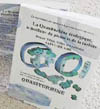



The Quasiturbine at the invention autopsy:
A bibliographic overview prior to 2012
Youtube Video Channel
Quasiturbine
Website before December 2004 (not maintained)
Homepage Debut
(go to starting homepage)
info@quasiturbine.com
514-527-8484
|